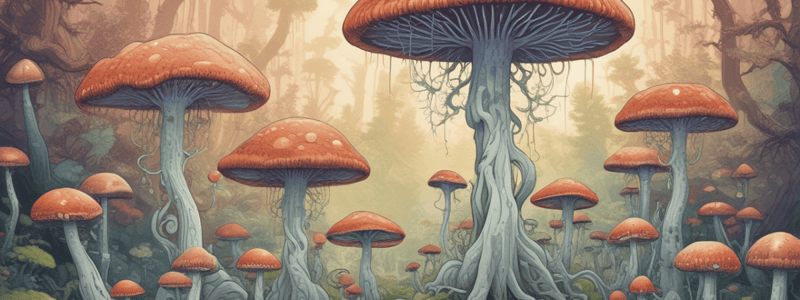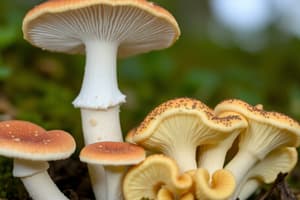Podcast
Questions and Answers
What type of fungus is most commonly associated with lichen symbiosis?
What type of fungus is most commonly associated with lichen symbiosis?
- Basidiomycete
- Zygomycete
- Oomycete
- Ascomycete (correct)
What is the main function of fungi in the guts of grazing mammals?
What is the main function of fungi in the guts of grazing mammals?
- Breakdown of plant material (correct)
- Synthesis of nitrogen
- Formation of mycorrhizae
- Production of antibiotics
What is the role of cyanobacteria in lichen symbiosis?
What is the role of cyanobacteria in lichen symbiosis?
- Provision of organic nitrogen (correct)
- Formation of soredia
- Provision of carbon compounds
- Degradation of fungal hyphae
What is the term for the symbiotic relationship between fungi and plant roots?
What is the term for the symbiotic relationship between fungi and plant roots?
What is the primary function of mycorrhizae in natural ecosystems?
What is the primary function of mycorrhizae in natural ecosystems?
Which type of fungus is involved in the decomposition of organic matter?
Which type of fungus is involved in the decomposition of organic matter?
What is the term for the small clusters of hyphae with embedded algae formed during asexual reproduction in lichens?
What is the term for the small clusters of hyphae with embedded algae formed during asexual reproduction in lichens?
What is the significance of lichens in the colonization of land by plants?
What is the significance of lichens in the colonization of land by plants?
What is the primary function of mycorrhizal fungi in a mutualistic relationship with plants?
What is the primary function of mycorrhizal fungi in a mutualistic relationship with plants?
Which type of mycorrhizal fungi penetrates root cells?
Which type of mycorrhizal fungi penetrates root cells?
What is the characteristic feature of coenocytic fungi?
What is the characteristic feature of coenocytic fungi?
What is the primary function of mycelium in fungi?
What is the primary function of mycelium in fungi?
Which of the following statements about mycorrhizae is false?
Which of the following statements about mycorrhizae is false?
What is the estimated number of fungal species?
What is the estimated number of fungal species?
What is the unique feature of fungi that helps identify them?
What is the unique feature of fungi that helps identify them?
What is the role of enzymes in fungal nutrition?
What is the role of enzymes in fungal nutrition?
What is the ecological importance of decomposition performed by fungi?
What is the ecological importance of decomposition performed by fungi?
Which of the following is an example of mutualism in fungi?
Which of the following is an example of mutualism in fungi?
What is the primary role of Basidiomycetes in ecosystem?
What is the primary role of Basidiomycetes in ecosystem?
Which of the following processes is NOT facilitated by mycorrhizal fungi?
Which of the following processes is NOT facilitated by mycorrhizal fungi?
What is the characteristic of fungal cell walls?
What is the characteristic of fungal cell walls?
Which type of fungi has specialized hyphae called haustoria?
Which type of fungi has specialized hyphae called haustoria?
Which of the following is a characteristic of Ascomycetes?
Which of the following is a characteristic of Ascomycetes?
What is the structure of fungi composed of?
What is the structure of fungi composed of?
Flashcards are hidden until you start studying
Study Notes
Fungus-Plant Mutualism
- Mycorrhizae are essential in natural ecosystems and agriculture
- Plants harbor harmless symbiotic endophytes, fungi that live inside leaves or other plant parts
- Endophytes produce toxins that deter herbivores and defend against pathogens
- Most endophytes are ascomycetes
Fungus-Animal Mutualism
- Fungi share their digestive services with animals
- Fungi help break down plant material in the guts of cows and other grazing mammals
- Many species of ants use the digestive power of fungi by raising them in “farms”
Lichens
- A lichen is a symbiotic association between a photosynthetic microorganism and a fungus
- Millions of photosynthetic cells are held in a mass of fungal hyphae
- The photosynthetic component is green algae or cyanobacteria
- The fungal component is most often an ascomycete
- The algae provide carbon compounds, cyanobacteria provide organic nitrogen, and fungi provide the environment for growth
- Lichens are important pioneers on new rock and soil surfaces
- Lichens may have helped the colonization of land by plants 550-600 million years ago
- Lichens are sensitive to pollution, and their death can be a warning that air quality is deteriorating
Fungal Structure
- The body of a fungus is made of a mycelium, which is an interwoven mass of hyphae
- Most fungi have hyphae divided into cells by septa, with pores allowing cell-to-cell movement of organelles
- Coenocytic fungi lack septa and have a continuous cytoplasmic mass with hundreds or thousands of nuclei
Mycorrhizae
- Mycorrhizae are mutually beneficial relationships between fungi and plant roots
- Mycorrhizal fungi deliver phosphate ions and minerals to plants
- Types of mycorrhizal fungi:
- Ectomycorrhizal fungi (do not penetrate root cells)
- Arbuscular mycorrhizal fungi (penetrate root cells)
Fungal Characteristics
- Fungi are diverse and widespread
- They are essential for the well-being of most terrestrial ecosystems
- About 100,000 species of fungi have been described
- It is estimated there are actually 1.5 million species of fungi
Fungal Nutrition
- Fungi are heterotrophs and absorb nutrients from outside of their body
- Fungi use enzymes to break down a large variety of complex molecules into smaller organic compounds
- The versatility of these enzymes contributes to fungi’s ecological success
- Fungi exhibit diverse lifestyles:
- Decomposers
- Parasites
- Mutualists
Fungal Morphology
- Some species grow as either filaments or yeasts; others grow as both
- The morphology of multicellular fungi enhances their ability to absorb nutrients
- Fungi consist of mycelia, networks of branched hyphae adapted for absorption
- A mycelium’s structure maximizes its surface area-to-volume ratio
- Fungal cell walls contain chitin
Studying That Suits You
Use AI to generate personalized quizzes and flashcards to suit your learning preferences.




